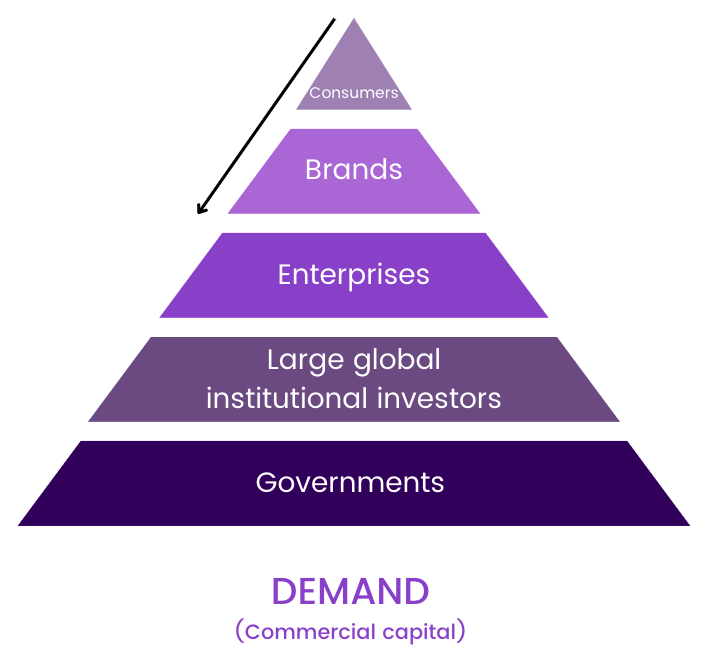The Climate Action Ecosystem: And how it can be leveraged to drive change

In a world where the resources we rely on are finite, the extractive nature of our sustenance places a heavy toll on our environment. Sustainable consumption among consumers has emerged as a vital driver of change and carries the power to shape the future of our planet. The rise of sustainability as a differentiating lever for businesses has the power to influence entire industries and policies. In order to incentivise stakeholders and mobilise the capital needed for the climate fight, the way we see and experience the world currently needs to undergo a momentous shift. At Climes, we visualise the financing structure for climate action as a top-down pyramid.

Power of consumer choice
Consumers today demand choices that minimise their environmental impact. This paradigm shift involves making thoughtful decisions about what they buy, how often they buy, and how they view the lifecycle of purchased goods. At its core, this consumer behaviour change strikes a much-needed balance between meeting present needs without compromising the ability of future generations to meet their own. While the per-capita contribution from consumers may not result in significant funds generated, it acts as an important catalytic push towards demanding more accountability from stakeholders who service them. On some level, that’s an implication on almost every business in the world. As Anshuman Bapna of Terra.do said while speaking on our podcast, “what seems like institutional structures start out with an individual making a decision first, it's effectively one of us making a decision and then building a whole ecosystem around it.” You can check out the rest of the podcast here.
Sustainability within consumer-centricity
As consumer demand for sustainable products rises, businesses are compelled to rethink their production methods and supply chains. This shift incentivises innovation, leading to the development of greener technologies, usage of renewable energy sources, adoption of circular economic models, and cutting of carbon emissions. Brands that genuinely embrace sustainability are rewarded with increased customer loyalty and positive brand associations. A grass-roots movement for more environmentally conscious supply chains can set off chain reactions that get noticed at the corporate, national, and international forums.
Accelerating large-scale climate finance
At the corporate level, aligning the right stakeholders, committing to a decarbonisation pathway, and executing the shift to less emissions-intensive supply chains require tying down sustainability goals with business goals. However, meaningful change requires significant resources. This is where financing carbon removal comes into play. To effectively scale up the fight against climate change, substantial investments are needed. Carbon financing provides the necessary funds to support renewable energy projects, reforestation efforts, sustainable agriculture practices, ocean-based carbon removal, and direct air capture. Companies finance projects to remove carbon from the atmosphere either directly or through carbon funds. This capital plays a vital role in reducing emissions and driving innovation within nature-based and engineered carbon removal.
The climate revolution
As momentum builds at the consumer and corporate levels, governments are compelled to align their policies with climate action goals. Policy changes can range from subsidies for renewable energy projects and carbon pricing mechanisms to stringent emissions regulations and sustainable infrastructure investments. By creating a supportive regulatory environment, governments facilitate the transition to a low-carbon economy and provide businesses and investors with the certainty they need to commit resources to long-term sustainability efforts. The symbiotic relationship between governments and consumers plays a critical role here in shaping the future for the next generation. Our internal moniker for the cohort of climate leaders as individuals and businesses is ‘Generation Climate’ or Gen-C, and it’s a set of Gen-C individuals who set up Gen-C businesses which then influence Gen-C policies and build Gen-C institutions.
At Climes, we’ve built products for every stakeholder along the way to do their part in financing the climate fight. We're betting on this new, inclusive form of climate action - and our products are designed to both leverage and enable this growing network of climate conscious change-makers. It's not just about discovering existing Gen-C actors, it's about building a platform that can help inspire and facilitate new ones to join, and lead ,this much needed global climate revolution.

